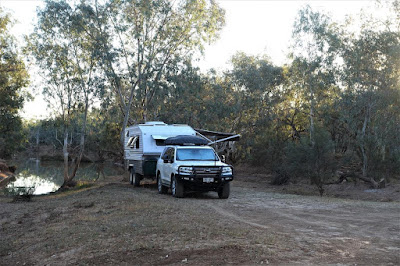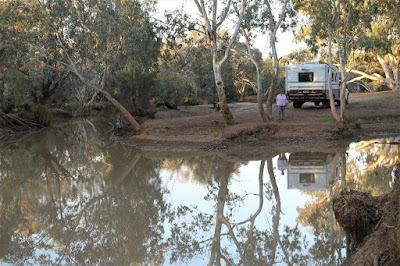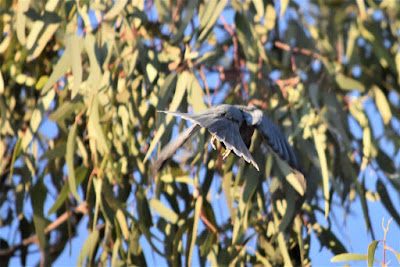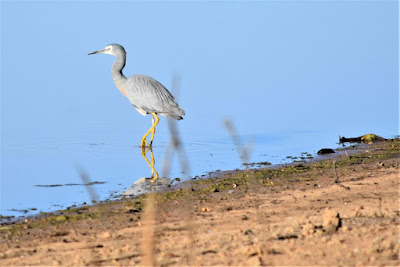Entry 17 Travelling south, Yowah to
Hungerford Qld. 10/9 – 20/9/2019
With phone and internet access we had propped
at the little opal mining town of Yowah (population around 70,) tracking our vital
caravan parts via the internet, coming from Melbourne to Brisbane to Stanthorpe
arriving at its final destination the town of Cunnamulla. Our parts were
ordered on a Tuesday afternoon, arriving at Cunnamulla the following Monday
afternoon, a travelling distance of about 3500 kilometres, leaving us delighted
with the service provided.
Once our parts were available for
collection, we relocated from the town’s free camp to the caravan park for
security reasons. Leaving the caravan at Yowah, as we thought we would be away
for several hours collecting our parts about 170 kilometres away at Cunnamulla.
We also obtained food and fuel, returning to Yowah to fit the new leaf spring.
Steve fitted the replacement part with
minimal fuss leaving us grateful with our decision not to travel with the
caravan to Cunnamulla in case there was a need for further assistance. Thus, saving
a couple of hundred kilometres of unnecessary travel with the caravan in tow.
 |
| Removing broken leaf from spring |
 |
| At work |
 |
| Fixed and even added a new pivot block for spring pack |
We did utilize the caravan parks
private artesian baths and its free washing machine which provided value to the
$10 a night fee we were paying. The caravan park had a small store where we
purchased bread and bananas at a cheaper price and of better quality than available
at the IGA supermarket at Cunnamulla the previous day.
 |
| Bath rooms |
 |
| Filling with artesian waters |
 |
| Recling in our baths gazing at the moon and stars |
Yowah was an interesting location with
similarities to the opal mining town of Cooper Pedy in South Australia, full of
colourful characters, pedalling their opals at rather exorbitant prices. One
lady offering us 30% discount on marked prices for that day only. Thus, instead
of paying $3,000 for a small rock sample, out of the goodness of her heart we
could obtain it at a bargain price of about $2,000. No thank you.
We were all hooked up ready to move on with
the tow tug motor running and was closing the caravan door for our departure when
a gust of wind swung the door breaking one of the hinges. More frustration and we
were at the stage, we just wanted to get out of Yowah. With some inventive
strategies we managed to secure the door shut, deciding to fix it at our next
stop. We had been debating the location of our next nights stop, with it being
decided when the door hinge broke, to be at a free camp location on the Paroo
River on the outskirts of Eulo about 65 kilometres down the road.
Steve searched his boxes of treasures
locating a spare door hinge. We felt justified carrying copious tools and spare
parts all over Australia, just from the last week of breakages incurred. It would
have saved many dollars in expenses, also minimising the incurred frustration from
being stranded many hundreds of kilometres from suitable assistance.
Our Paroo River camp spot was most
enjoyable on the eyes and senses. It was a no brainer staying a second night.
We loved the setting of this location with an easy kilometre walk to town for a
look around the township of Eulo. We had initially walked around the camping
area finding a separate entry point to a camping spot away from the crowds of
campers located nearby the main road, though we could still hear any loud noises
from the main road area.
Just a few more pictures showing our
surrounds viewed from our caravan windows enticing us to leave all our curtains
open to catch the early morning views and sounds.
 |
| Sunset |
 |
| Moon Rising |
We had made commitments paying in
advance for campground fees at Currawinya National Park about 75 kilometres
down the road in a camp spot described as close to the Paroo River. We were
hoping it would be as good as our current free camp spot on the Paroo River at
Eulo. With our tow tug and caravan tyre pressures reduced to help combat some
expected rough dirt road conditions we were on our way. Travelling at our
accustomed slow rate of speed we were happy with the road condition, experiencing
minimal jolting.
There were three different campground
locations in the first section of the national park we had entered and we had
unintentionally booked a site in the campground located furthest away. We
deviated to inspect the closest campground and were immediately happy with our
eyes tantalised by a nearby sighting of a Bustard Bird.
The campground, ‘Corni Paroo
Waterhole,’ was pleasing on the eye with many camping options along the edge of
the Paroo River with views across the water hole and flat plains we had driven
across to this location. Driving out we spotted the Bustard Bird again and a
large flock of green budgies or similar.
The second campground, ‘Caiwarro Waterhole,’ appeared to be about 10 kilometres
in another direction and we decided to view this location another day. Our
destination campground, ‘Pump Hole,’ appeared to possibly be on the other side
of Corni Paroo Waterhole, with many camping options located down an embankment
with campsites right on the water’s edge.
 |
| The old pump |
We were delighted with our first
experience of Currawinya National Park. The only disappointment, ‘it was fly
time of the year.’ Every time we stepped outside, we were swamped by hundreds
of thousands of flies getting into our eyes even with glasses on, into our ear
canals making us feel uncomfortable. The fly presence had been increasing over
the last several hundred kilometres of travels, possibly first noticeable
around Longreach.
Our first three days in Currawinya N.P.
camped at the Pump Hole campground we didn’t see another soul. It was a similar
setting to our Eulo camp, but more blissful with no other distracting noises,
100% nature and us. We had an accompaniment of chirping birds during the day
and beautiful silence, at night. The daytime temperature climbed above 30 C and
we decided to partake in one of the advertised activities, having a swim in the
waters. The top 25 millimetres of water was a nice temperature but once we sunk
further into its depths it felt like an ice bath with no enticement to stay in
for any length of time. Though one of the locals came to see what all the
commotion was about.
 |
| Steve |
 |
| Mary |
We were now having discussions about
adding to our list of equipment, an insect screen structure where we could
enjoy lounging about with views of the great outdoors without having to deal
with annoying insects. After three nights at Pump Hole campground we decided to
drive with our caravan in tow to check out Caiwarro Waterhole. Yes, the flies
were very annoying and we thought a change of setting might distract us for a
while from the flies.
A few more pictures taken of our
setting, tantalising our senses whilst at the Pump Hole campground.
 |
| Native honey bees |
It was a dusty drive to Caiwarro
Waterhole along a single width dirt track. The camping area was high above the
water with a scramble down a steepish embankment to get to the water edge. The
camping areas were carved up with water ruts, rendering the surface quite
uneven making it unstable under foot. Any thoughts for staying a while at
Caiwarro Waterhole were quickly snuffed out.
 |
| A close up view of our vehicle mirror showing dust created travelling at 20 kph |
 |
| The mirror at same location |
We decided to set camp at Corni Paroo
Waterhole with lovely river views and views across the plains. It seems on
arrival at Currawinya N.P. we had inadvertently set camp in the best setting of
this area at the Pump Hole campground.
For us the Paroo River had a setting similar
to many camping spots we had experienced along the River Murray which travels
from New South Wales, through Victoria and South Australia. The Paroo River is
about 600 km long, lined with coolabah, yapunyah and river red gum trees and is
claimed to be the last free flowing river in the entire Murray-Darling basin.
Currawinya N.P. wetlands and waterways are important inland waterbird habitats
with recognised international significance.
Camped on the plains of Corni Paroo
Waterhole we did manage to view some different birds and scenery.
 |
| Parrots flying by at a fast rate |
 |
| The same mob of parrots |
 |
| Sunrise |
 |
| Sunrise |
We woke to an icy cold wind and decided
to continue south through the National Park. We viewed the crumbled remains of the
Old Caiwarro Homestead site.
About 45 kilometres down the road we
stopped at the ranger base where there was a phone hot spot and we paid for
another night’s camp fee via the internet, as required by Queensland National
Parks. We had a look at the nearby Currawinya Woolshed, another interesting
shearing shed which had quite a few out buildings all secured restricting our
exploration activities.
We set camp about 1 kilometre down the
road from the Woolshed at Ourimperee Waterhole a similar camping area to Corni
Paroo Waterhole, only larger. There was even an open top cold shower complex.
 |
| Clothing for the comfort of your eyes, discarded when camera turned off |
Currawinya National Park had caught our
attention a few years prior, reading an interesting article about its
international significance. This was our first visit to this remote location
and we were not disappointed with our experience. The below picture from one of
these publicity shots.
Disappointingly the publicised
significance for the existence of Currawinya National Park, two large lakes
supporting 200 species of birds and an area set aside where native Bilbies had
been reintroduced, have restricted access for normal people like us. Both of
these locations we would have loved the opportunity to experience in the format
of the publicity photographs.
It was time to continue our travels and
we said goodbye to Currawinya N.P. A few photograph’s taken during our last
morning at Ourimperee Waterhole.
Our next stop 20 kilometres down the
road was in the town of Hungerford located at the border of Queensland and New
South Wales. There was no mobile phone reception and we saw three other locals
during our stay, the publican, someone at the bar and a lady walking across the
road. We stayed in the caravan park for $11 a night with power, hot shower and
a free washing machine.
 |
| We saw more of these than locals |
Late afternoon two camper trailers set
up in the caravan park with two couples. Their chatter seemed so loud and the
local roosters started up at 4 am. We were already missing the beautiful
serenity of Currawinya N.P.
With our freshly washed clothes packed
away and nice clean bodies we were onto our next destination about 90
kilometres down the road at Comeroo Station. Just prior to leaving we lowered
our tyre pressures another 3psi (normal for us 47 – 50psi) down to 28psi as the
road conditions were becoming rough and corrugated. As it transpired, we were
pleased with the decision to lower our tyre pressures which help to soften the
jarring caused by driving on rough corrugated roads.
We do travel at a slow rate of speed
when the road conditions deteriorate and this day’s section of road was the most
punishing, we had experienced this year. There were many kilometres of jarring
corrugations, sections of road with pot holes camouflaged by dust, sections of
road feeling like we were driving through soft sand requiring an extra
depressed accelerator to get us through. It took us just over two and half
hours to drive the required 90 kilometres to our destination at Comeroo Station,
another bush camp location, arriving feeling exhausted from the extra concentration
focused on the road conditions.
We had the choice of two locations to
set camp. One near the farm house with chickens, roosters, ducks, dogs and
goats, all making you very aware of their presence, or a bit further out next
to the river. We chose the river location without the not so quiet animals. We
did enjoy the artesian waters bath.


























































No comments:
Post a Comment